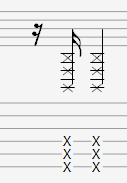1) GUITAR 101
1a) Introduction
Hi, everyone. I thought it would be helpful to provide breakdowns of memorable guitar parts from famous songs in order to help teach non-guitarists how to "think" like a guitarist. I noticed a lot of creators are interested in making rock or metal songs, but are struggling to make their guitar sound like, well, a real guitar played by an actual guitarist and not just a cheesy MIDI.
I will gradually be adding songs to this thread ranging from rock, to metal, to acoustic songs. Feel free to request specific songs and specific sections of the song, because I think I will only be breaking down about 8-12 bars per song.
The breakdowns will include explanations of how a guitar works, genre-specific techniques, genre/role-specific tones (as in guitar pedals/drop tuning), highlighting riffs, and showing how it all fits in with other instruments in the song.
1b) A bit of info about real guitars
Guitars generally have 6 strings and are electric (plug into an amp) or acoustic. The thickest and thinnest string are sometimes in the same tuning. The thickest string is the most important, it usually indicates the "tuning" your guitar. For example, "Standard" tuning actually means "E Standard", referring to the low E string.
Standard tuning means the strings are tuned to E A D G B E:
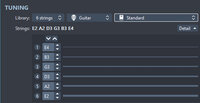
^ Notice that string #1 is the thinnest string and string #6 is the thickest string illustrated by a gradually thickening horizontal line.
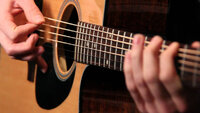
^ However, be aware that real guitars have the thickest string on top.
You can expect that acoustic guitars will mostly be in standard tuning. However, electric guitars have a much wider range of tuning and you can expect them to be "drop tuned". In the above image, the octave is indicated in addition to the letter name. Pay attention to this, as the octave tends to drop for rock and even more for metal.
Note #1: You can expect that for acoustic guitars, players like to go the opposite route and use a capo to shorten their strings and raise the octaves (compared to metal dropping their range as low as possible).
Note #2: Guitars can actually have more than 6 strings. Some metal guitarists can have 7 or 8 strings (or even pay to have a custom guitar with more strings), this lets them have high notes for special parts in the song while being able to chug on the very low tuned strings.
1c) Drop tuning
Not only do alternate tunings make it so that certain chords are easier for guitarists to play (such as power chords), but they also allow the player to drop their octaves and give the guitar an intimidating low sound. Other common tunings that gradually get lower-sounding are Drop D, Drop C, Drop B, and many more in between.
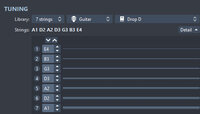
^ Example of a 7 string guitar in Drop D tuning.
1d) You will probably need more than 1 guitar
In real bands, you will almost always have at least 2 guitarists.
1) Lead guitar: The lead guitarist is the guitar hero who plays an iconic riff or does the sick shredding solos.
2) Rhythm guitar: This person usually plays chords for the entire song. While they are not as iconic as the lead guitar, they are arguably more important. Chords play throughout the entire song and they do a strumming pattern to keep the beat. The way they play the chords-- how fast, if they hit every 1 2 3 4 beat or not, if they use upstrokes or downstrokes-- can completely change the feeling and genre of a song.
It will be your duty to make one track for the chords/rhythm guitar and one for the flamboyant solos/riffs. Separating these two roles is very important in composing the parts of your song. It will also help when you get to the step of assigning an amp tone to each of them that fits their role and doesn't overpower the song.
Note: For an acoustic song, you might only need one rhythm guitar. Imagine a man playing guitar by a campfire. The minimum amount he can do is simply strum and sing. Of course, his playing style can become more complex by adding techniques like tapping on the guitar, playing fingerstyle arpeggios, or mixing in a melody for improv.
2. THE UNIQUE SOUND OF A GUITAR
2a) Tone (not just important for guitarists)
Tone is a very important word for guitarists. When an idolized guitarist has their own signature tone, people really envy it and wonder how they got their sound. It is a combination of their playing skills, technique, but most relevant for non-guitarists: it is also a combination of their amp and guitar pedals. You won't have to learn lightning fast shredding skills, you will just have to be aware of guitar roles (lead usually needs a "clean" effect) vs rhythm (could be anything ranging from distortion to fuzz depending on genre) and how to use virtual amps/pedals.
^ Lead guitar: Different types of tones for various genres.
^ Examples of using the incorrect tone for your genre
2b) Guitar pedals customize tone
Some DAWs let you use a virtual pedal board/virtual stomps that can be arranged in different orders to achieve the desired effect.
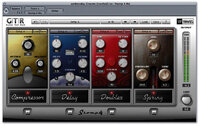
^ Image of a VST with pedals you can turn on/off, change dial settings, and rearrange.
^ Video of real pedals being demonstrated to show their sounds.
^ Some genres really rely on special pedals, such as ambient. There are many tutorials on YouTube of people demonstrating how they chain their pedals, so go ahead and research your target genre.
1a) Introduction
Hi, everyone. I thought it would be helpful to provide breakdowns of memorable guitar parts from famous songs in order to help teach non-guitarists how to "think" like a guitarist. I noticed a lot of creators are interested in making rock or metal songs, but are struggling to make their guitar sound like, well, a real guitar played by an actual guitarist and not just a cheesy MIDI.
I will gradually be adding songs to this thread ranging from rock, to metal, to acoustic songs. Feel free to request specific songs and specific sections of the song, because I think I will only be breaking down about 8-12 bars per song.
The breakdowns will include explanations of how a guitar works, genre-specific techniques, genre/role-specific tones (as in guitar pedals/drop tuning), highlighting riffs, and showing how it all fits in with other instruments in the song.
1b) A bit of info about real guitars
Guitars generally have 6 strings and are electric (plug into an amp) or acoustic. The thickest and thinnest string are sometimes in the same tuning. The thickest string is the most important, it usually indicates the "tuning" your guitar. For example, "Standard" tuning actually means "E Standard", referring to the low E string.
Standard tuning means the strings are tuned to E A D G B E:

^ Notice that string #1 is the thinnest string and string #6 is the thickest string illustrated by a gradually thickening horizontal line.

^ However, be aware that real guitars have the thickest string on top.
You can expect that acoustic guitars will mostly be in standard tuning. However, electric guitars have a much wider range of tuning and you can expect them to be "drop tuned". In the above image, the octave is indicated in addition to the letter name. Pay attention to this, as the octave tends to drop for rock and even more for metal.
Note #1: You can expect that for acoustic guitars, players like to go the opposite route and use a capo to shorten their strings and raise the octaves (compared to metal dropping their range as low as possible).
Note #2: Guitars can actually have more than 6 strings. Some metal guitarists can have 7 or 8 strings (or even pay to have a custom guitar with more strings), this lets them have high notes for special parts in the song while being able to chug on the very low tuned strings.
1c) Drop tuning
Not only do alternate tunings make it so that certain chords are easier for guitarists to play (such as power chords), but they also allow the player to drop their octaves and give the guitar an intimidating low sound. Other common tunings that gradually get lower-sounding are Drop D, Drop C, Drop B, and many more in between.

^ Example of a 7 string guitar in Drop D tuning.
1d) You will probably need more than 1 guitar
In real bands, you will almost always have at least 2 guitarists.
1) Lead guitar: The lead guitarist is the guitar hero who plays an iconic riff or does the sick shredding solos.
2) Rhythm guitar: This person usually plays chords for the entire song. While they are not as iconic as the lead guitar, they are arguably more important. Chords play throughout the entire song and they do a strumming pattern to keep the beat. The way they play the chords-- how fast, if they hit every 1 2 3 4 beat or not, if they use upstrokes or downstrokes-- can completely change the feeling and genre of a song.
It will be your duty to make one track for the chords/rhythm guitar and one for the flamboyant solos/riffs. Separating these two roles is very important in composing the parts of your song. It will also help when you get to the step of assigning an amp tone to each of them that fits their role and doesn't overpower the song.
Note: For an acoustic song, you might only need one rhythm guitar. Imagine a man playing guitar by a campfire. The minimum amount he can do is simply strum and sing. Of course, his playing style can become more complex by adding techniques like tapping on the guitar, playing fingerstyle arpeggios, or mixing in a melody for improv.
2. THE UNIQUE SOUND OF A GUITAR
2a) Tone (not just important for guitarists)
Tone is a very important word for guitarists. When an idolized guitarist has their own signature tone, people really envy it and wonder how they got their sound. It is a combination of their playing skills, technique, but most relevant for non-guitarists: it is also a combination of their amp and guitar pedals. You won't have to learn lightning fast shredding skills, you will just have to be aware of guitar roles (lead usually needs a "clean" effect) vs rhythm (could be anything ranging from distortion to fuzz depending on genre) and how to use virtual amps/pedals.
^ Lead guitar: Different types of tones for various genres.
^ Examples of using the incorrect tone for your genre
2b) Guitar pedals customize tone
Some DAWs let you use a virtual pedal board/virtual stomps that can be arranged in different orders to achieve the desired effect.

^ Image of a VST with pedals you can turn on/off, change dial settings, and rearrange.
^ Video of real pedals being demonstrated to show their sounds.
^ Some genres really rely on special pedals, such as ambient. There are many tutorials on YouTube of people demonstrating how they chain their pedals, so go ahead and research your target genre.
Last edited:














